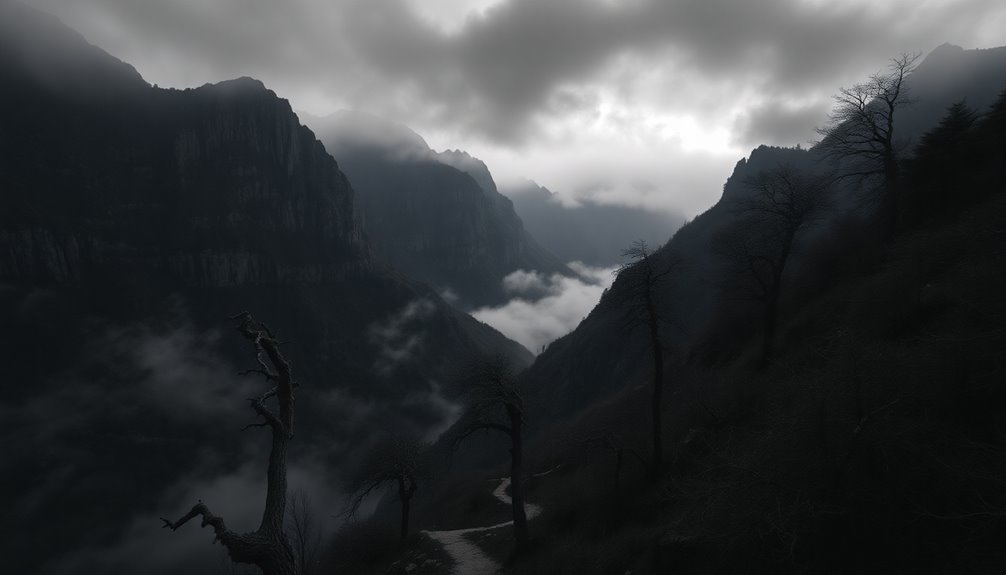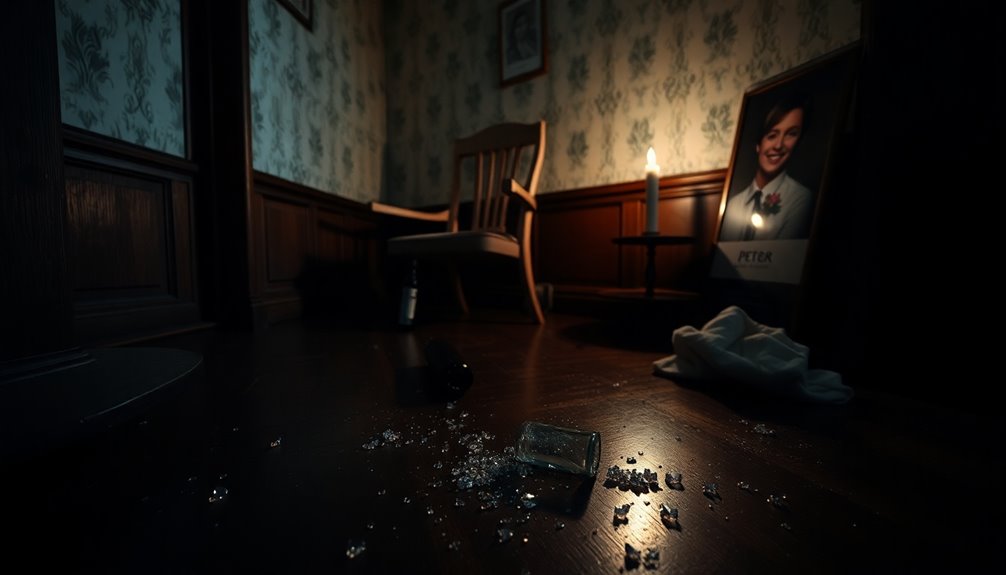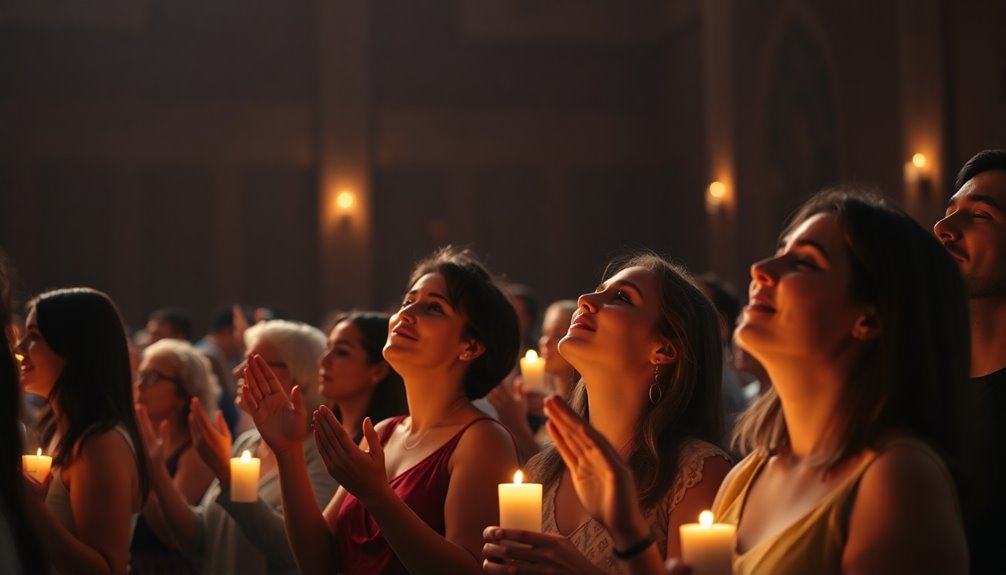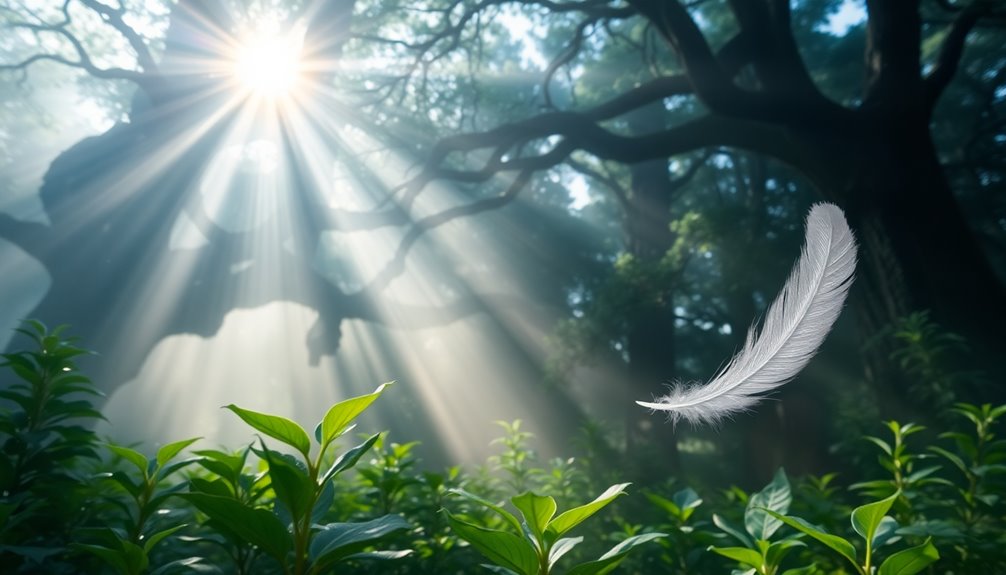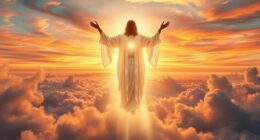The "Valley of the Shadow of Death," originating from Psalm 23:4, symbolizes the deep fears and hardships you encounter in life. It's often represented through art and historical contexts, like Roger Fenton's photograph from the Crimean War that captures the perilous reality soldiers faced. This valley reflects the dark moments you endure, yet it also emphasizes divine guidance and comfort, reassuring you that you're never truly alone. The imagery extends beyond funerals, representing ongoing struggles and resilience. To gain deeper insights into its significance, there's much more to explore about its cultural and spiritual impacts.
Key Takeaways
- The phrase "Valley of the Shadow of Death" originates from Psalm 23:4, symbolizing life's darkest challenges and God's guidance through them.
- It reflects the historical context of the Crimean War, where high casualty rates highlighted soldiers' struggles, as seen in Roger Fenton's photography.
- The metaphor serves as a reminder of divine presence, offering hope and resilience amid fear, as echoed in various biblical passages.
- Artistic representations of the valley convey themes of despair and hope, illustrating personal and societal struggles during conflict.
- The phrase emphasizes the importance of faith and trust in divine protection during tumultuous times and contemporary mental health discussions.
Introduction

In the journey of life, fear and uncertainty often loom like shadows in a dark valley. You might find yourself navigating through the valley of the shadow, a metaphorical space representing the challenges and dangers life throws your way.
Originating from Psalm 23:4, this phrase evokes the image of steep, dark canyons, historically thought to lie between Jerusalem and Jericho, known for their treacherous paths.
In contemporary interpretations, it's often referred to as the "darkest valley," broadening its meaning to encompass various struggles, fears, and adversities. This vivid imagery resonates, reminding you that everyone faces tough times, and you're not alone in feeling this weight.
The shepherd metaphor embedded in this context offers reassurance, emphasizing the divine guidance and protection you can depend on during your most trying moments.
The valley of the shadow transcends its biblical origins, appearing in literature and art, symbolizing resilience and the human spirit's confrontation with mortality.
As you explore this concept deeper, consider how it reflects your own experiences and the strength you can draw from them.
Biblical Passages Overview

As you explore the biblical passages related to the "valley of the shadow of death," you'll find key references that highlight both its significance and broader meanings.
Primary and secondary Bible references paint a vivid picture of life's struggles and the divine support available to you during tough times.
Understanding these passages can deepen your appreciation for the comfort and hope they provide.
Primary Bible References
Many recognize the phrase "valley of the shadow of death" from Psalm 23:4, a powerful depiction of God's presence during challenging times. This verse emphasizes God's protection and comfort when you face life's darkest moments. Various translations interpret the valley of the shadow of death differently, with some opting for "darkest valley," which broadens the understanding of life's trials beyond just death.
The valley symbolizes a steep, dark canyon, often linked to the perilous route between Jerusalem and Jericho, where travelers encountered numerous dangers. In this context, the imagery illustrates the intimate relationship between a shepherd and their sheep, highlighting the reassurance of divine guidance amid fear and uncertainty.
While Psalm 23:4 is frequently read at funerals, its primary intention is to provide strength and comfort to you as you navigate through life's challenges. Recognizing that God walks with you through the valley of the shadow of death can inspire hope and resilience, reminding you that even in the darkest times, you're not alone.
This verse serves as a powerful reminder of divine presence, encouraging you to trust in that guidance.
Secondary Bible References
The comfort offered in Psalm 23:4 resonates deeply within other biblical passages that underscore God's unwavering presence during difficult times. Isaiah 41:10 echoes this sentiment, reassuring you not to fear because God is with you, providing strength and help as you navigate through life's valleys, including the valley of the shadow of death. This protective imagery complements the assurance found in Psalm 23:4.
In John 10:11-15, Jesus embodies the role of the Good Shepherd, laying down His life for the sheep. This illustrates divine protection in the face of danger, reinforcing the relationship you share with Him.
Moreover, 2 Timothy 1:7 reminds you that God has given you a spirit of power, love, and self-control to combat the fears that arise when facing daunting challenges.
Finally, Romans 8:38-39 assures you that nothing can separate you from the love of God, a promise that resonates with the comfort of Psalm 23:4. Together, these passages create a powerful tapestry of hope, reminding you that God's presence remains steadfast, even in the darkest valleys.
Crimean War Backdrop

Why did the Crimean War become a defining moment in military history? This conflict, fought from 1853 to 1856, marked a significant shift in warfare and public perception. The war involved the UK, the Second French Empire, the Kingdom of Sardinia, and the Ottoman Empire against the Russian Empire. Amidst the brutal battles, the phrase "Valley of the Shadow of Death" emerged, highlighting the high casualty rates from relentless shelling.
British photographer Roger Fenton captured the harrowing essence of this war with his iconic photograph titled "The Valley of the Shadow of Death" in 1855. In this image, you see a road strewn with cannonballs, a stark symbol of the perils faced by soldiers.
Fenton's work didn't just document the conflict; it shaped how the public viewed war, bringing the grim realities of combat into the homes of everyday people. This was a pivotal moment in the history of war photography, as it bridged the gap between the battlefield and public consciousness, ultimately influencing how future wars would be perceived and recorded.
The Crimean War truly set the stage for modern warfare and its representation.
Symbolism of the Landscape

Imagining the landscape of the "Valley of the Shadow of Death" evokes a stark and haunting imagery that resonates deeply with the human experience of fear and adversity. This valley, speculated to lie between Jerusalem and Jericho, symbolizes the steep, dark canyons of life's most troubling moments. Its treacherous terrain reflects the challenges you may face, where sunlight barely penetrates except at noon, reinforcing the feelings of darkness and despair.
In this landscape, dangers lurk, much like the instinctual threats sheep encounter in dark valleys. You can see how the valley embodies life's trials, requiring guidance and protection from a shepherd. The symbolism here is profound; it emphasizes the journey through difficulties while highlighting the necessity of divine companionship.
Each step taken in the shadow of death becomes a testament to resilience, where the landscape mirrors your struggles and growth.
Ultimately, this valley isn't just a geographical feature; it's a powerful metaphor within Psalm 23, urging you to confront your fears while seeking strength and guidance to navigate through life's daunting shadows.
Misunderstanding the Photograph's Context

When you look at Roger Fenton's "Valley of the Shadow of Death," it's easy to assume it captures the raw danger of war.
However, misconceptions about its context can cloud your understanding of its historical accuracy and artistic intent.
Let's unpack how these misunderstandings shape our perception of this iconic image.
Debunk Common Misconceptions
Misconceptions about the "Valley of the Shadow of Death" often stem from a misunderstanding of its context and composition. Many people assume that the photograph captures a genuine battlefield scene, but the reality is more complex. Taken by Roger Fenton during the Crimean War in 1855, the image depicts a road scattered with cannonballs, which some argue may have been staged for dramatic effect. This raises questions about the authenticity of the valley's portrayal and the shadow it casts over our understanding of war.
You might also be surprised to learn that there are two versions of the photograph—one featuring the cannonballs and another without. This discrepancy fuels debates about what Fenton intended to convey.
Additionally, the title itself, referencing Psalm 23:4, heightens the emotional weight of the image, linking it to themes of fear and mortality rather than simply documenting the aftermath of battle. Understanding these nuances can help you appreciate Fenton's work beyond its initial appearance, allowing you to see how the context shapes your perception of this powerful piece of history.
Historical Accuracy Concerns
Amid the compelling imagery of Roger Fenton's "Valley of the Shadow of Death," concerns about historical accuracy emerge, prompting viewers to question the photograph's authenticity.
Taken during the Crimean War in 1855, the image captures a haunting scene in a location known for heavy shelling. However, the presence of cannonballs in one version raises significant historical accuracy concerns. Some argue Fenton staged the shot for dramatic effect, while others believe soldiers might've moved the cannonballs for reuse, complicating the interpretation.
Filmmaker Errol Morris's investigation in 2007 suggests that the version without cannonballs may have been the first taken, indicating potential alterations after the initial capture. This revelation challenges the notion of a straightforward representation of war, pushing you to reconsider what the photograph conveys.
As you engage with this iconic image, it's crucial to recognize how the choices made in its creation affect our understanding of historical events.
Cultural Reflection in Art

When you explore art inspired by the "Valley of the Shadow of Death," you see how it reflects individual struggles during conflict.
Artists channel their experiences of faith and resilience, creating powerful narratives that resonate with your own challenges.
This cultural reflection not only portrays despair but also offers a glimpse of hope amidst adversity. Furthermore, these works often emphasize the importance of open communication as a means to rebuild trust and resolve conflict in personal relationships.
Individual Reflection on Conflict
Conflict is an inevitable part of the human experience, often captured in art that reflects our deepest struggles. When you navigate your own darkest valley, you might find solace in the works of writers and artists who've tread similar paths. John Bunyan's "The Pilgrim's Progress," for instance, presents the valley as a metaphor for the spiritual challenges you face, reminding you that adversity can be a profound teacher.
Edgar Allan Poe and C.S. Lewis delve into existential themes, illustrating the battle between light and darkness that resonates with your own inner conflicts. You may encounter emotional weight in Francis Danby's paintings, where the tension between despair and hope becomes palpable, mirroring your journey through life's trials.
The phrase "Valley of the Shadow of Death" has transcended its religious origins, now echoing in military contexts and motivational speeches. This evolution speaks to the universal nature of conflict, encouraging you to reflect on your courage and resilience. Furthermore, the emotional support and counseling available through breast cancer treatment can serve as a vital resource as you confront your personal challenges.
As you engage with these artistic interpretations, you come to understand that your struggles aren't isolated but rather part of a collective human experience, fostering a deeper connection with others.
Faith in Times of Conflict
The exploration of faith during tumultuous times often finds expression in various forms of art, revealing how individuals grapple with their beliefs amidst adversity.
For instance, John Bunyan's "The Pilgrim's Progress" encapsulates the essence of navigating the "Valley of the Shadow of Death," symbolizing the struggle against fear and uncertainty. Artists like Francis Danby use their canvases to depict despair and hope, demonstrating how faith can inspire resilience in the face of conflict.
Roger Fenton's iconic photograph from the Crimean War starkly illustrates the dangers of battle, evoking feelings of mortality while underscoring the need for trust in something greater.
This imagery resonates deeply with contemporary discussions about mental health, where the "valley" becomes a metaphor for anxiety and fear, reminding you of the importance of faith.
The ongoing relevance of the "Valley of the Shadow of Death" in modern art and media highlights its cultural significance.
It acts as a powerful reminder that, even amidst life's challenges, the quest for divine comfort and support can help you navigate through the darkest times with renewed strength and purpose.
Final Thoughts on Interpretation

In exploring the interpretation of "valley of the shadow of death," you can find profound insights that resonate with many aspects of life. This phrase, often seen as a metaphor for life's dark valley, symbolizes the challenges and fears we all face. It reminds you that these trials aren't just about physical death; they encompass any difficult situation that feels overwhelming.
Alternative translations like "darkest valley" emphasize the temporary nature of your struggles, suggesting that they can eventually lead to growth and understanding. The imagery of the shepherd in this scripture highlights the intimate relationship between you and God, offering comfort during times of uncertainty.
When you confront adversity, this verse reassures you that you're not alone. God's presence serves as a source of strength, helping you navigate through your fears.
Additional Resources

Exploring the "Valley of the Shadow of Death" can lead you to a wealth of additional resources that deepen your understanding of this powerful metaphor.
Start with Psalm 23:4, where the imagery of the valley conveys fear and danger, reminding you of life's challenges. Various Bible translations, like the NIV's "darkest valley," highlight the theme of struggle.
You might also consider historical contexts, such as the perilous canyons between Jerusalem and Jericho, often depicted in biblical narratives.
Works by authors like John Bunyan and Edgar Allan Poe showcase the valley's influence in literature, while Roger Fenton's photograph from the Crimean War visually connects danger with this imagery.
To further explore this concept, delve into commentaries on Psalm 23 that discuss the significance of the "rod and staff" as symbols of guidance and protection.
Understanding these elements can enhance your appreciation of the presence of God, which offers comfort amid life's darkest moments.
Frequently Asked Questions
What Does the Valley of the Shadow of Death Mean in the Bible?
In the Bible, the phrase "valley of the shadow of death" symbolizes the darkest moments in life when you face fear and uncertainty.
It represents the challenges and trials that can feel overwhelming.
However, this verse assures you that you're not alone; God's presence acts as a comforting guide through these tough times.
Is the Valley of the Shadow of Death a Real Place?
You might wonder if the valley of the shadow of death is a real place.
While some scholars suggest it refers to a specific canyon, there's no universally recognized physical location. Instead, it symbolizes life's darkest moments, representing fear and adversity.
This imagery resonates with many, as it captures the challenges everyone faces.
What Is the Shadow of Death in the Bible?
The "shadow of death" in the Bible represents a metaphorical space filled with fear and danger rather than a literal encounter with death.
It symbolizes life's darkest moments and challenges where uncertainty looms. This phrase emphasizes the emotional struggles you might face, but it also assures you that God's presence offers comfort and guidance.
In your toughest times, you can find solace, knowing you're not alone in facing these adversities.
What Is the Meaning of Psalm 23 Verse 4?
Psalm 23:4 reassures you that, even in your darkest moments, you're not alone. The verse emphasizes God's comforting presence, reminding you that you don't have to fear any danger.
With God as your shepherd, you can find peace and guidance, knowing He's always there to protect you. The rod and staff symbolize His support, offering reassurance that you can rely on Him during life's challenges and uncertainties.

